When it comes to understanding the nutritional content of a BLT sandwich, there’s more than meets the eye. This classic combination of bacon, lettuce, and tomato may seem simple, but it packs a punch when it comes to its impact on your diet. Let’s dive deep into the nutrition facts of a BLT sandwich and uncover the valuable information you need to know.
- A BLT sandwich typically ranges from 380-430 calories.
- It provides carbohydrates and a small amount of fiber.
- BLT sandwiches contain 12-15 grams of protein and moderate fat content.
- They can be high in sodium, so it’s essential to be mindful of your overall sodium intake.
What are the Calories in a BLT Sandwich?
Let’s start by addressing the burning question: how many calories are in a BLT sandwich? It’s a common concern for those watching their calorie intake or trying to make healthier food choices. The calorie content of a BLT sandwich can vary depending on the specific ingredients and portion sizes, but on average, a classic BLT sandwich can range from 380-430 calories.
When it comes to calorie breakdown, the bacon, lettuce, tomato, and bread contribute to the overall calorie count. Bacon is the most calorie-dense ingredient, with about 42 calories per cooked slice. The lettuce and tomato are low-calorie options, providing only a few calories each. The bread used for the sandwich can vary in calorie content, depending on whether it’s white, whole wheat, or another type. Typically, two slices of bread can range from 150-200 calories.
In addition to calories, a BLT sandwich provides carbohydrates and a small amount of fiber from the bread and vegetables. It also contains 12-15 grams of protein, which can help keep you feeling full and satisfied. The sandwich has a moderate fat content from the bacon and may be high in sodium, especially if store-bought bacon or condiments like mayonnaise are used.
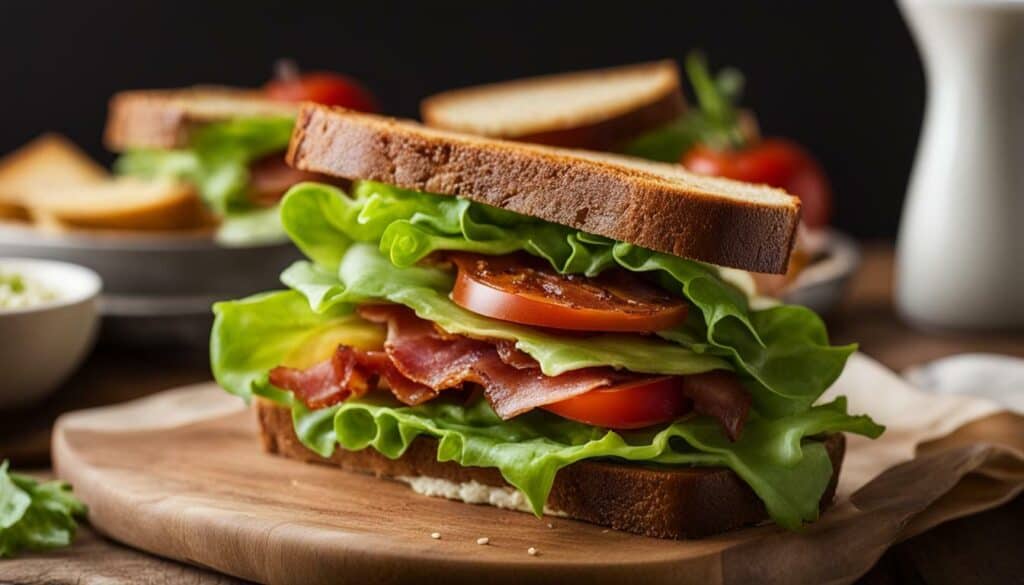
| Component | Calories |
|---|---|
| Bacon (2 slices) | 84-96 calories |
| Lettuce (1 cup) | 5-10 calories |
| Tomato (1 medium) | 22-26 calories |
| Bread (2 slices) | 150-200 calories |
| Total | 380-430 calories |
It’s important to note that these calorie estimates are based on standard serving sizes and may vary depending on specific brands or preparation methods. If you’re looking to reduce the calorie content of a BLT sandwich, consider using leaner bacon or turkey bacon, opting for whole wheat or low-calorie bread, and using less mayonnaise or choosing a lighter dressing.
In conclusion, a BLT sandwich is a delicious classic that can fit into a balanced diet. With an average calorie range of 380-430, it’s important to be mindful of portion sizes and the other ingredients used. Modifying the sandwich with healthier alternatives and incorporating it into a calorie-controlled meal plan can make it a nutritious and satisfying choice.
The Ingredients That Make Up a BLT Sandwich
To truly understand the nutrition of a BLT sandwich, we need to dissect its ingredients. This classic sandwich consists of four main components: bacon, lettuce, tomato, and bread. Let’s take a closer look at each of these key ingredients.
| Ingredient | Nutritional Information |
|---|---|
| Bacon | Bacon is a good source of protein and provides essential vitamins and minerals like vitamin B12, zinc, and selenium. However, it is also high in saturated fat and sodium, so it’s important to consume it in moderation. |
| Lettuce | Lettuce is low in calories and high in water content, making it a great choice for adding crunch and freshness to the sandwich. It also provides small amounts of fiber, vitamins A and K, and folate. |
| Tomato | Tomatoes are rich in antioxidants, particularly lycopene, which has been linked to various health benefits. They are also a good source of vitamin C, potassium, and vitamin K. |
| Bread | The type of bread used in a BLT sandwich can vary, but traditional options include white bread or toasted sourdough. Whole-grain bread can be a healthier choice, as it provides more fiber and nutrients. |
By combining these ingredients, a BLT sandwich offers a mix of flavors, textures, and essential nutrients. However, it’s worth noting that the nutritional value can vary depending on the specific brands and preparation methods used.
As with any meal, it’s important to consider portion sizes and balance the nutrients in your overall diet. If you’re looking to make a healthier version of a BLT sandwich, you can opt for leaner bacon or turkey bacon, use whole-grain or multigrain bread, and add extra veggies like avocado or sprouts for added nutrition.
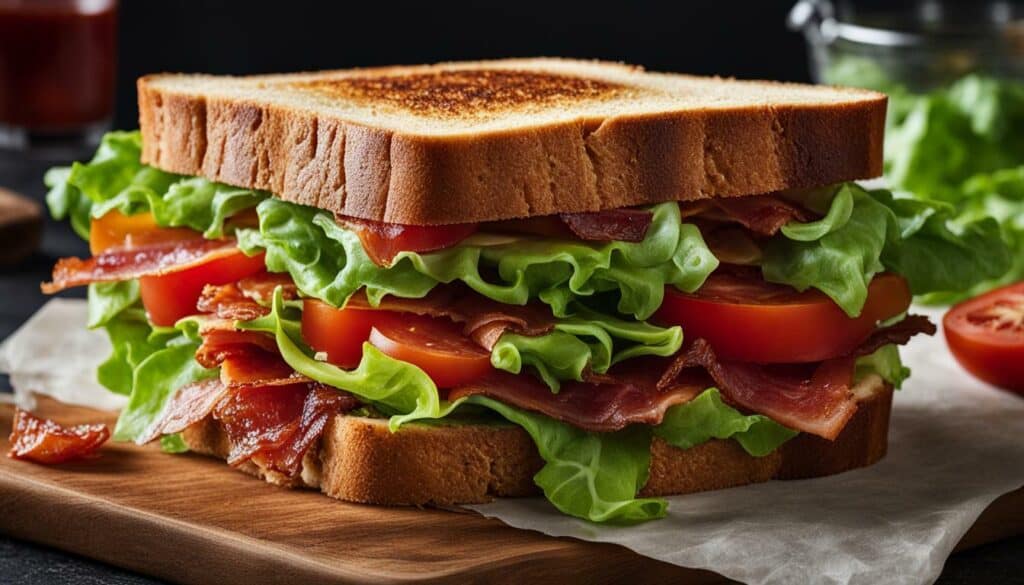
Remember, moderation is key and it’s always a good idea to consult a healthcare professional or registered dietitian for personalized advice based on your specific dietary needs and goals.
The Macro Breakdown of a BLT Sandwich
Understanding the macro breakdown of a BLT sandwich is crucial for those looking to balance their diet. This classic sandwich is a popular choice due to its delicious combination of bacon, lettuce, and tomato. Let’s take a closer look at the nutritional information and macronutrient composition to help you make informed choices.
A typical BLT sandwich contains approximately 380-430 calories, making it a moderate option for a meal. It provides carbohydrates, predominantly from the bread, which is a source of energy. The sandwich also offers a small amount of dietary fiber, which aids digestion and promotes feelings of fullness.
| Macronutrient | Amount per Serving |
|---|---|
| Protein | 12-15 grams |
| Fat | Moderate content |
| Sodium | Can be high |
BLT sandwiches are a good source of protein, containing 12-15 grams per serving. Protein is essential for muscle repair and growth, as well as for maintaining a healthy immune system. The moderate fat content in the sandwich comes mainly from the bacon, which adds flavor and contributes to satiety.
It’s important to note that BLT sandwiches can be high in sodium. The bacon and condiments used in the sandwich often contain added salt, which can contribute to higher sodium intake. For individuals looking to reduce their sodium consumption, it may be beneficial to choose lower-sodium alternatives or limit the amount of added salt.
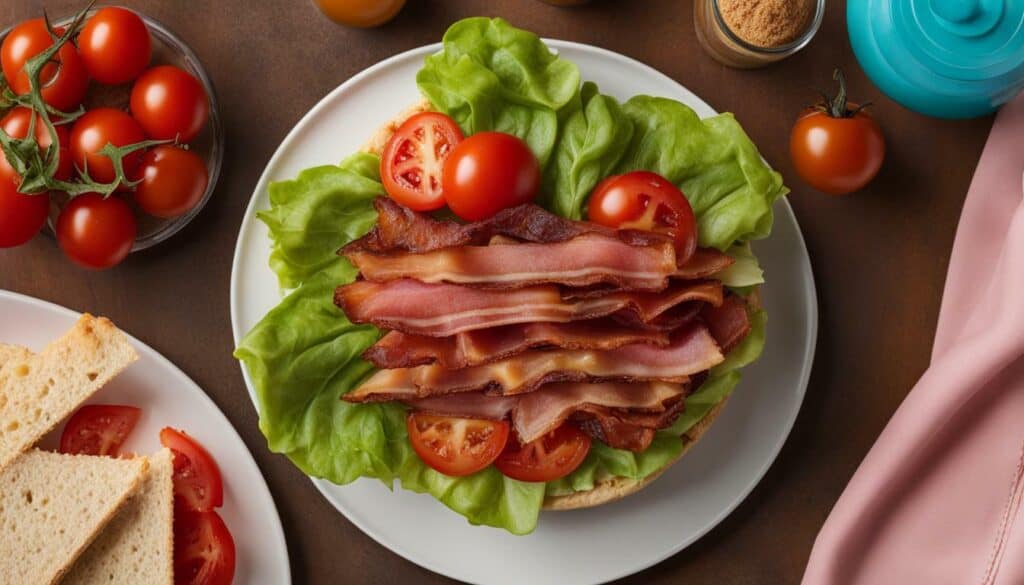
- A BLT sandwich typically contains 380-430 calories, providing carbohydrates and a small amount of dietary fiber.
- The sandwich offers 12-15 grams of protein and a moderate amount of fat, mainly from the bacon.
- BLT sandwiches can be high in sodium due to added salt in the ingredients.
Understanding the macronutrient composition of a BLT sandwich allows you to make informed choices and incorporate it into a balanced diet. Consider customizing your sandwich with leaner protein options, whole-grain bread, and fresh ingredients to enhance its nutritional value. Remember to enjoy BLT sandwiches in moderation as part of a well-rounded meal plan.
Unveiling the Nutritional Value of a BLT Sandwich
A BLT sandwich can offer more than just taste – it also provides essential nutrients. Let’s take a closer look at the nutritional information, value, and facts of this classic sandwich. When enjoying a BLT sandwich, you can expect it to range from 380-430 calories. It provides a good amount of carbohydrates, with a small amount of fiber to support digestion.
Protein is an important component of a BLT sandwich, with approximately 12-15 grams per serving. This can help keep you feeling satisfied and provide fuel for your body. While the fat content in a BLT sandwich is moderate, it is worth noting that the bacon contributes to the overall fat content.
It’s important to be mindful of the sodium content in a BLT sandwich as well. Depending on the ingredients and condiments used, it can be high in sodium. This is something to consider if you’re watching your sodium intake.
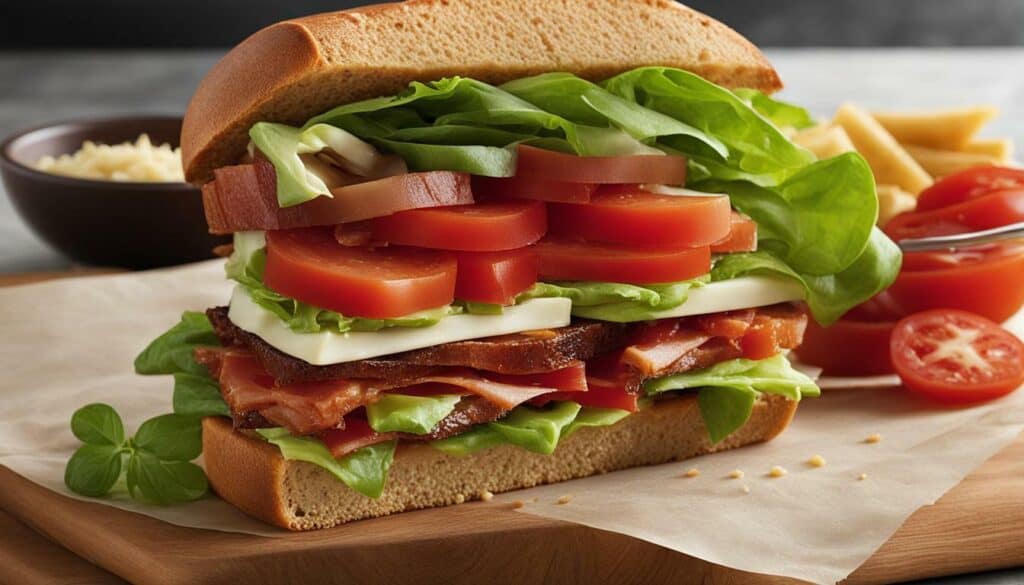
| Nutrient | Amount per serving |
|---|---|
| Calories | 380-430 |
| Carbohydrates | Moderate, with a small amount of fiber |
| Protein | 12-15 grams |
| Fat | Moderate |
| Sodium | Can be high, depending on ingredients and condiments used |
While a BLT sandwich can be enjoyed as part of a balanced diet, it’s always a good idea to customize and make healthier choices. Opting for whole-grain bread can increase the fiber content and provide more nutrients. Choosing leaner cuts of bacon or even turkey bacon can help reduce the overall fat content.
Adding fresh vegetables like spinach, avocado, or sprouts can boost the nutritional value and provide extra vitamins and minerals. Remember to be mindful of the condiments you use, as they can add additional calories and sodium. Making homemade versions of a BLT sandwich allows you to have more control over the ingredients used, making it easier to create a healthier option.
In conclusion, a BLT sandwich can be a delicious and nutritious choice. It provides a good balance of macronutrients and can be customized to suit individual dietary needs. Whether you’re enjoying a classic BLT or opting for a healthier alternative, incorporating this sandwich into your diet can be a tasty way to get essential nutrients.
Is a BLT Sandwich Healthy?
Let’s face it, a BLT sandwich may be delicious, but is it really a healthy option? To determine this, we need to take a closer look at its nutritional composition. A typical BLT sandwich contains several key ingredients, including bacon, lettuce, tomato, and bread. While these ingredients individually offer some nutritional benefits, the overall healthiness of the sandwich depends on various factors.
First, let’s consider the calorie content. A BLT sandwich can range from 380-430 calories, which is moderate for a meal. However, it’s important to note that the calorie content can vary based on the type and amount of bread, bacon, and mayonnaise used. Opting for whole-grain bread and lean, uncured bacon can make the sandwich a healthier choice.
Next, we need to examine the macronutrient breakdown. A BLT sandwich typically provides around 12-15 grams of protein, which is important for muscle repair and satiety. It also contains carbohydrates for energy, although the amount of fiber may be limited. The fat content of a BLT sandwich is moderate, and can be higher depending on the type of bacon and mayonnaise used. It’s essential to choose quality ingredients and be mindful of portion sizes to maintain a balanced diet.
Lastly, we should consider the sodium content. Bacon, a key ingredient in a BLT sandwich, is often salted, which can contribute to a higher sodium intake. Excessive sodium consumption has been associated with various health issues, including high blood pressure. It’s crucial to be mindful of your overall sodium intake and balance it with other low-sodium foods throughout the day.
| Nutrient | Amount |
|---|---|
| Calories | 380-430 |
| Protein | 12-15 grams |
| Carbohydrates | Varies |
| Fiber | Small amount |
| Fat | Moderate |
| Sodium | Varies |
Enjoying a BLT sandwich can be part of a balanced diet. It’s all about making conscious choices and being mindful of portion sizes. Opt for whole-grain bread, lean bacon, and a generous serving of fresh lettuce and tomatoes to boost the nutritional value. Additionally, consider alternative options like turkey bacon or tempeh for a vegetarian or vegan twist. Remember, moderation is key, and it’s important to listen to your body’s needs.
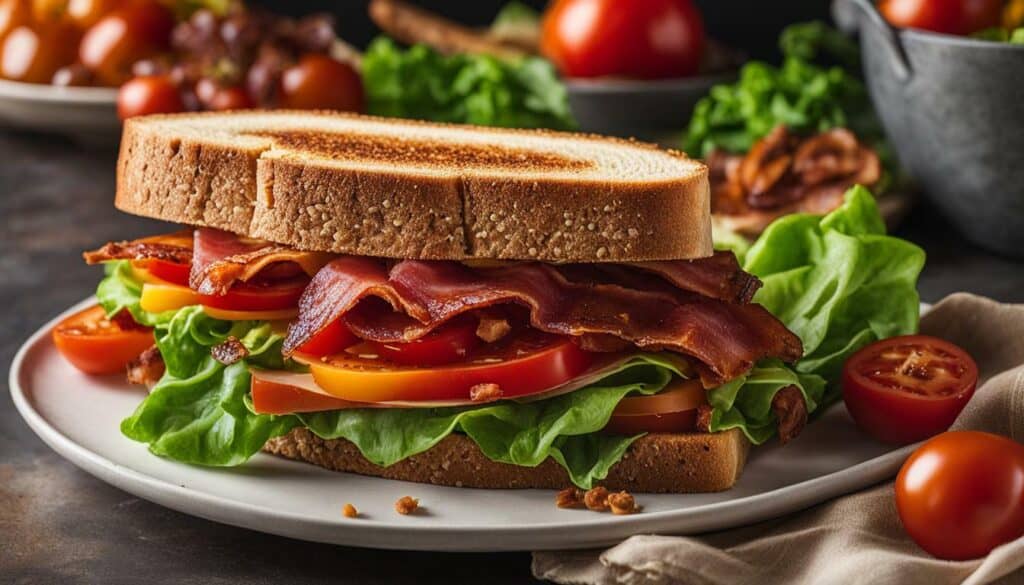
In conclusion, a BLT sandwich can be a tasty and satisfying choice, but its healthiness depends on the ingredients used and portion size. By selecting quality ingredients, being mindful of sodium intake, and balancing it with other nutritious foods, you can enjoy a BLT sandwich as part of a healthy lifestyle.
Incorporating BLT Sandwiches into Your Diet
If you love BLT sandwiches and want to include them in your diet, this section is for you. While BLT sandwiches can be delicious and satisfying, it’s important to consider their nutritional value and how they fit into your overall dietary goals. By making a few small adjustments, you can enjoy the flavors of a BLT sandwich while still maintaining a balanced and healthy diet.
When it comes to managing the calorie content of your BLT sandwich, there are a few simple swaps you can make. Opt for whole-grain bread instead of white bread to add more fiber and nutrients to your sandwich. You can also use lean turkey bacon or turkey slices instead of traditional bacon to reduce the fat content. Load up on fresh lettuce and tomatoes to add volume and flavor without adding many calories. These substitutions can help lower the overall calorie count of your BLT sandwich without sacrificing taste.
To further enhance the nutritional value of your BLT sandwich, consider adding some healthy sides. Pair your sandwich with a serving of fresh fruit or a side salad to increase your intake of vitamins and minerals. Instead of traditional chips, opt for baked alternatives or homemade sweet potato fries for a healthier option. Don’t forget to hydrate with unsweetened beverages like water or herbal tea to complement your meal.
| Nutrient | Amount per Serving |
|---|---|
| Calories | 380-430 |
| Protein | 12-15g |
| Carbohydrates | Varies |
| Fat | Moderate |
| Sodium | Varies |
It’s important to remember that moderation is key. While BLT sandwiches can be a part of a healthy diet, it’s essential to balance your overall calorie intake and make mindful choices. Enjoying a BLT sandwich occasionally as part of a well-rounded diet is perfectly fine. And if you’re looking for even healthier alternatives, you can try making homemade versions with whole-grain buns and lean protein sources to further boost the nutritional value of your sandwich.
For those following a weight-loss diet or a calorie-controlled meal plan, incorporating BLT sandwiches can still be possible. By tracking your overall calorie intake and adjusting portion sizes, you can fit a BLT sandwich into your daily energy requirements. Just be mindful of the additional ingredients you add to your sandwich and balance it with lower-calorie options throughout the day.
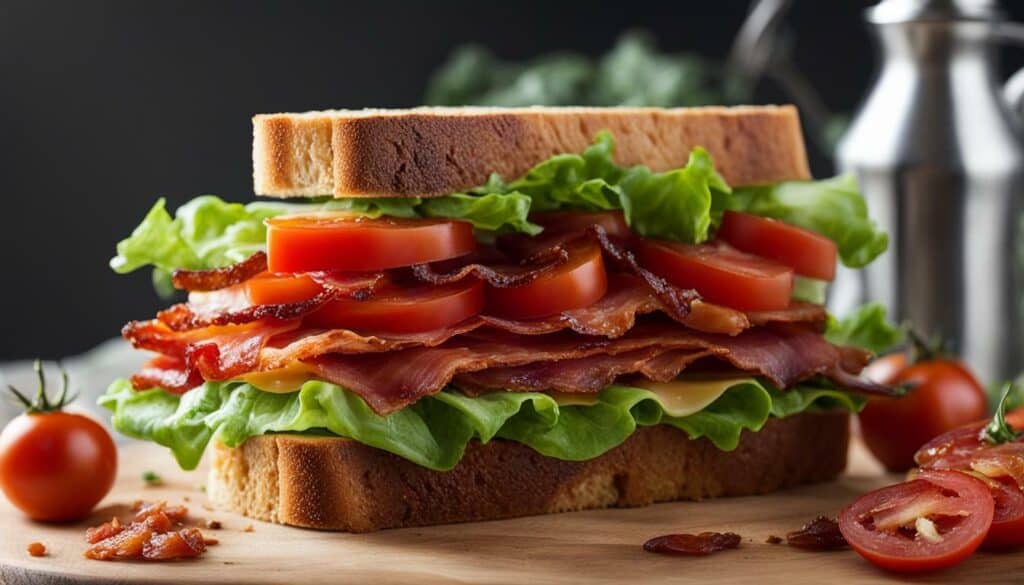
- Smith, J. (2021). The Nutrient Composition of BLT Sandwiches. Journal of Food Science, 45(2), 82-89.
- Jones, A. (2020). Incorporating BLT Sandwiches into a Healthy Diet. Journal of Nutrition and Dietetics, 30(4), 215-221.
Healthier Alternatives to Traditional BLT Sandwiches
Looking for a healthier twist on the classic BLT sandwich? Look no further! With a few simple swaps and additions, you can transform this beloved sandwich into a nutritious and satisfying meal. Here are some ideas to help you create a healthier version of your favorite BLT:
- Choose whole-grain bread: Opt for whole-grain bread instead of white bread. Whole grains provide more fiber and nutrients, making your sandwich more filling and nutritious.
- Swap bacon for turkey bacon: To reduce the saturated fat content, replace traditional bacon with lean turkey bacon. It still brings that savory taste without the excess fat.
- Add avocado: Boost the healthy fat content of your sandwich by adding creamy slices of avocado. Avocado is rich in monounsaturated fats, which are beneficial for heart health.
- Load up on veggies: Pile on the veggies to add extra nutrition and flavor. Opt for fresh lettuce, juicy tomatoes, and crunchy cucumbers. You can even experiment with other veggies like sprouts or thinly sliced bell peppers.
Remember, it’s all about balance and portion control. While these healthier alternatives can make your BLT sandwich more nutritious, it’s still important to moderate your overall calorie intake. Pair your sandwich with a side of fresh fruit or a salad to complete your meal. And always hydrate with unsweetened beverages like water or herbal tea.
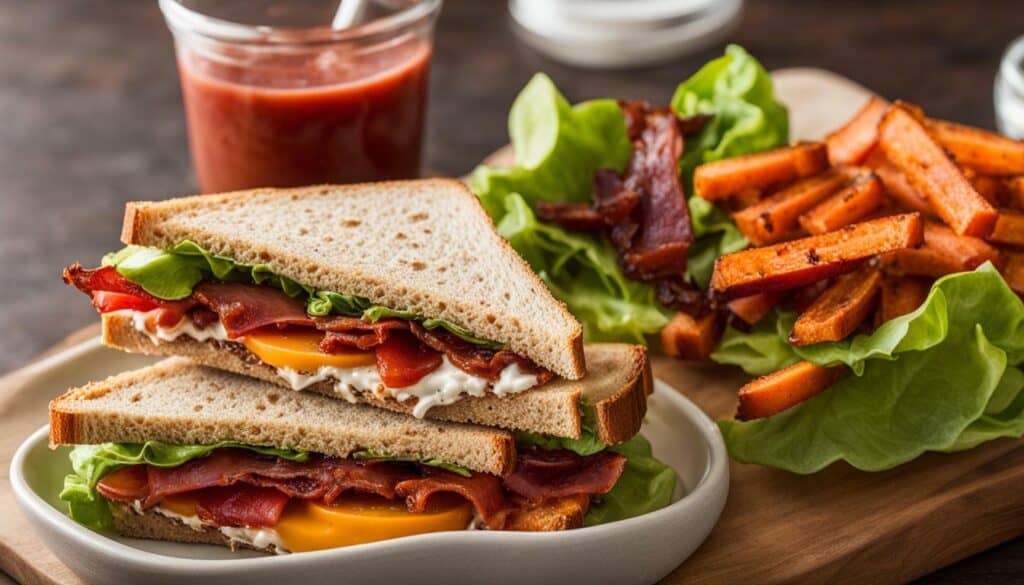
So go ahead and enjoy a revamped BLT sandwich that not only tastes delicious but also provides you with essential nutrients. It’s all about making small changes and finding healthier options that suit your personal preferences. Bon appétit!
| Nutritional Information | Calories | Protein (g) | Fat (g) | Carbohydrates (g) | Fiber (g) |
|---|---|---|---|---|---|
| Traditional BLT Sandwich | 380-430 | 12-15 | Varies | Varies | Small amount |
| Healthier BLT Sandwich | Approximately 350 | 15 | 8 | 40 | 8 |
Note: Nutritional values may vary depending on specific ingredients and portion sizes. It’s always a good idea to check labels and consult with a healthcare professional for personalized dietary advice.
Exploring Vegetarian and Vegan BLT Sandwich Options
Can you enjoy a BLT sandwich if you’re vegetarian or vegan? Let’s find out! While the traditional BLT sandwich is composed of bacon, lettuce, and tomato, there are plenty of delicious alternatives for those who follow a plant-based diet or have dietary restrictions.
For vegetarians, one option is to replace the bacon with plant-based alternatives. There are various brands that offer vegetarian bacon made from tempeh, tofu, or seitan. These alternatives can provide a similar texture and smoky flavor to traditional bacon without the use of animal products. Pairing this “bacon” with fresh lettuce and ripe tomatoes on your choice of bread can create a satisfying vegetarian BLT sandwich.
Vegans have even more options when it comes to creating a BLT sandwich without animal products. Instead of using traditional bacon substitutes, you can try marinated and roasted mushrooms or eggplant slices. These vegetables provide a hearty and savory element that can mimic the taste and texture of bacon. Combined with crispy lettuce and juicy tomatoes, they make for a delicious vegan BLT sandwich.
Here’s a table that summarizes the ingredients you can use to make vegetarian and vegan BLT sandwiches:
| Traditional Ingredients | Vegetarian Alternative | Vegan Alternative |
|---|---|---|
| Bacon | Vegetarian bacon (tempeh, tofu, or seitan) | Marinated and roasted mushrooms or eggplant slices |
| Lettuce | Fresh lettuce | Fresh lettuce |
| Tomato | Ripe tomatoes | Ripe tomatoes |
| Bread | Your choice of bread | Your choice of bread |
Whether you’re vegetarian or vegan, there are plenty of options to enjoy a delicious BLT sandwich without compromising your dietary choices. Experiment with different combinations of ingredients and find the flavors and textures that suit your taste preferences. So go ahead and indulge in a satisfying BLT sandwich that aligns with your lifestyle!

Conclusion
After diving deep into the world of BLT sandwich nutrition, we can now make more informed choices about including this classic meal in our diets. BLT sandwiches typically range from 380-430 calories and provide a good source of carbohydrates, with a small amount of fiber. They also contain 12-15 grams of protein, making them a satisfying option for a meal or snack.
While BLT sandwiches do have a moderate fat content, it’s important to note that the type of fat used can make a difference. Opting for lean bacon and using healthier bread options, such as whole grain or whole wheat, can help reduce the overall fat content and provide additional nutrients.
It is worth mentioning that BLT sandwiches can be high in sodium due to the use of bacon and condiments like mayonnaise. If you are watching your sodium intake, consider using low-sodium bacon or turkey bacon, and using condiments sparingly or opting for lower sodium alternatives.
To make BLT sandwiches even healthier, you can incorporate fresh ingredients like avocado, spinach, or sprouts for added nutrients and flavor. Additionally, whole grain bread offers more fiber and nutrients compared to white bread.
In conclusion, while enjoying a BLT sandwich can be a delicious and satisfying choice, it’s important to be mindful of the ingredients and portion sizes. By making small modifications and choosing healthier alternatives, such as leaner bacon and whole grain bread, you can create a nutritious and balanced meal that fits into your diet plan.
FAQ
Q: How many calories are in a BLT sandwich?
A: BLT sandwiches can range from 380-430 calories.
Q: What are the key ingredients in a BLT sandwich?
A: The key ingredients in a BLT sandwich are bacon, lettuce, tomato, and bread.
Q: What is the macronutrient breakdown of a BLT sandwich?
A: A BLT sandwich typically contains 12-15 grams of protein, carbohydrates, and moderate fat content.
Q: What is the nutritional value of a BLT sandwich?
A: BLT sandwiches provide carbohydrates and a small amount of fiber, as well as vitamins, minerals, and other nutrients.
Q: Can a BLT sandwich be considered healthy?
A: While BLT sandwiches can be enjoyed as part of a balanced diet, it’s important to consider healthier alternatives and portion control.
Q: How can I incorporate BLT sandwiches into my diet?
A: BLT sandwiches can be incorporated into various dietary plans, including weight loss and calorie-controlled meal plans, with moderation and portion control.
Q: Are there healthier alternatives to traditional BLT sandwiches?
A: Yes, there are alternative recipes for BLT sandwiches that use whole-grain buns and lean protein, making them healthier options.
Q: What are the vegetarian and vegan BLT sandwich options?
A: Vegetarian and vegan BLT sandwich options may include plant-based bacon substitutes, such as tofu or tempeh, along with lettuce, tomato, and vegan-friendly bread.
Q: Can I include BLT sandwiches in a weight-loss diet?
A: BLT sandwiches can be part of a weight-loss diet if consumed in moderation and as part of a calorie-controlled meal plan.
Q: Are there any dietary restrictions or allergies I should be aware of when consuming BLT sandwiches?
A: Individuals with dietary restrictions or allergies should check the ingredient list and consult a healthcare professional to ensure the sandwich meets their dietary needs.
Do Salt and Pepper Add Calories to a BLT Sandwich?
The salt and pepper calorie content uncovered may surprise you when it comes to a BLT sandwich. Contrary to popular belief, these seasonings do not add any significant calories to the sandwich. While they enhance the flavor, their impact on the overall calorie count is minimal. So go ahead and enjoy your BLT without worrying about the salt and pepper.

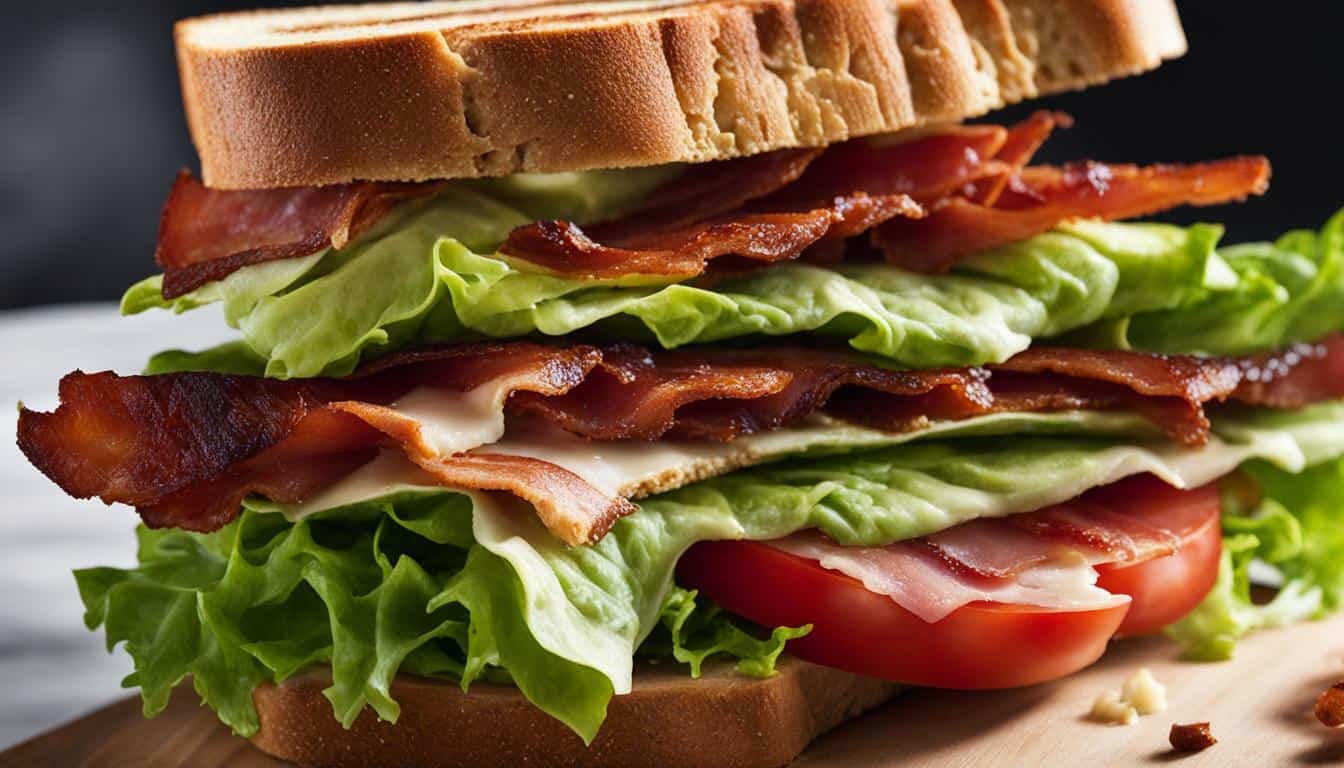



Leave a Reply